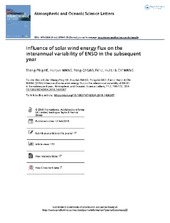| dc.contributor.author | He, Shengping | |
| dc.contributor.author | Wang, Hui-Jun | |
| dc.contributor.author | Gao, Yongqi | |
| dc.contributor.author | Li, Fei | |
| dc.contributor.author | Li, Hui | |
| dc.contributor.author | Wang, Chi | |
| dc.date.accessioned | 2018-08-23T06:22:05Z | |
| dc.date.available | 2018-08-23T06:22:05Z | |
| dc.date.issued | 2018 | |
| dc.Published | He S, Wang H, Gao Y, Li F, Li H, Wang. Influence of solar wind energy flux on the interannual variability of ENSO in the subsequent year. Atmospheric and Oceanic Science Letters. 2018;11(2):165-172 | eng |
| dc.identifier.issn | 1674-2834 | en_US |
| dc.identifier.uri | https://hdl.handle.net/1956/18200 | |
| dc.description.abstract | Previous studies have tended to adopt the quasi-decadal variability of the solar cycle (e.g. sunspot number (SSN) or solar radio flux at 10.7 cm (F10.7) to investigate the effect of solar activity on El Niño–Southern Oscillation (ENSO). As one of the major terrestrial energy sources, the effect of solar wind energy flux in Earth’s magnetosphere (Ein) on the climate has not drawn much attention, due to the big challenge associated with its quantitative estimation. Based on a new Ein index estimated by three-dimensional magnetohydrodynamic simulations from a previous study, this study reveals that Ein exhibits both quasi-decadal variability (periodic 11-year) and interannual (2–4 years) variability, which has rarely before been detected by SSN and F10.7. A significant interannual relationship between the annual mean Ein and subsequent early-winter ENSO is further revealed. Following high Ein, the sea level pressure in the subsequent early winter shows significant positive anomalies from Asia southward to the Maritime Continent, and significant negative anomalies over the Southeast and Northeast Pacific, resembling the Southern Oscillation. Meanwhile, significant upper-level anomalous convergence and divergence winds appear over the western and eastern Pacific, which is configured with significant lower-level anomalous divergence and convergence, indicating a weakening of the Walker circulation. Consequently, notable surface easterly wind anomalies prevail over the eastern tropical Pacific, leading to El Niño-like sea surface temperature anomalies. It is suggested that better describing the processes in the solar wind–magnetosphere–ionosphere coupled system is essential to understand the solar influence on climate change. | en_US |
| dc.language.iso | eng | eng |
| dc.publisher | Taylor & Francis | en_US |
| dc.rights | Attribution CC BY | eng |
| dc.rights.uri | http://creativecommons.org/licenses/by/4.0 | eng |
| dc.title | Influence of solar wind energy flux on the interannual variability of ENSO in the subsequent year | en_US |
| dc.type | Peer reviewed | |
| dc.type | Journal article | |
| dc.date.updated | 2018-06-14T07:30:17Z | |
| dc.description.version | publishedVersion | en_US |
| dc.rights.holder | Copyright 2018 The Author(s) | en_US |
| dc.identifier.doi | https://doi.org/10.1080/16742834.2018.1436367 | |
| dc.identifier.cristin | 1591071 | |
| dc.source.journal | Atmospheric and Oceanic Science Letters | |

